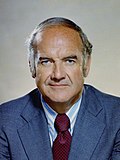User:KohnSmith03/sandbox
| |||||||||||||||||||||||||||||||||
| Turnout | 87.4%[1] | ||||||||||||||||||||||||||||||||
|---|---|---|---|---|---|---|---|---|---|---|---|---|---|---|---|---|---|---|---|---|---|---|---|---|---|---|---|---|---|---|---|---|---|
| |||||||||||||||||||||||||||||||||
 Presidential election results map. Blue denotes states won by Clinton/Gore and red denotes those won by Bush/Quayle. Numbers indicate electoral votes cast by each state and the District of Columbia. | |||||||||||||||||||||||||||||||||
| |||||||||||||||||||||||||||||||||
The 1952 United States presidential election was the 42nd quadrennial presidential election. It was held on Tuesday, November 4, 1952. Republican Dwight D. Eisenhower defeated Progressive President Glen H. Taylor (replacing President Henry A. Wallace) and Democratic Senator Harry S. Truman in a landslide victory, becoming the first Republican president in 20 years.
Following the removal of Wallace from the Democratic Party, Truman brokered a deal with Strom Thurmond and emerged victorious on the third presidential ballot of the 1952 Democratic National Convention, defeating Tennessee Senator Estes Kefauver, Senator Alben W. Bakely, and other candidates. This caused a mass exodus of progressives, liberals, and labor unionists from the Democratic Party.
The Republican nomination was primarily contested by Eisenhower, a general, widely popular for his leadership in World War II, and the conservative Ohio Senator Robert A. Taft. As a hung convention loomed, Eisenhower brokered a deal with the conservative wing of the Republican Party wherein he selected Senator Joseph P. McCarthy as his running mate and won the nomination.
The Progressive nomination went to Glen H. Taylor, who had succeeded Walalce as President after his assasination. Franklin D. Roosevelt Jr., representative from New York and the son of the late President of the same name, had succeeded Taylor as Vice President and joined him on the ticket. Despite abysmal approval ratings, a lack of campaign infrastructure, and a wave of anti-communism, the Progressive ticket beat expectations, partially due to the endorsements of notable figures like Eleanor Roosevelt.
Democrats and Republicans attacked President Wallace and Taylor's handling of the Korean War and the broader Cold War, alleging Soviet spies infiltrated the U.S. government. TIn the first televised presidential campaign, Eisenhower was charismatic and very well known, in sharp contrast to Taylor and Truman. Truman tried to tie himself to the popular Roosevelt administration and campaigned on the popularity of the New Deal and stoked fears of another Great Depression under a Republican administration. Taylor promised to continue the legacy of Wallace and to continue to expand the New Deal, pitching his New American Prosperity Program (NAPP). Taylor attacked the Democrats for ousting Wallace and for endangering the legacy of Roosevelt, and attacked the Eisenhower for his conservative economics and embrace of McCarthy.
- ^ "National General Election VEP Turnout Rates, 1789-Present". United States Election Project. CQ Press. Archived from the original on July 25, 2014. Retrieved February 21, 2023.



